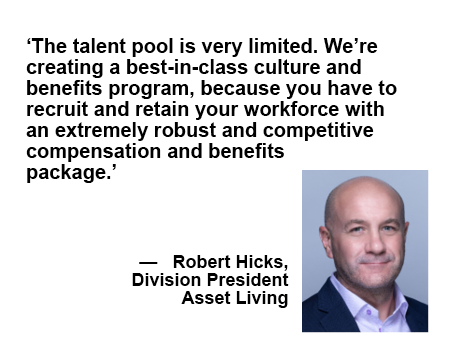Sensing a shift in the wind, multifamily property manager Asset Living is preparing for a bumpier leasing environment amid rising supply, slowing rent growth and overall economic uncertainty.
While an adjustment, it shouldn’t come as a complete shock, says Robert Hicks, an Asset Living division president in charge of the conventional multifamily business in the western United States. Over the past handful of years, the sector has enjoyed some of the highest occupancies he has seen in his 25-year career in the industry, he points out. At the same time, landlords generally were able to significantly raise rental rates and had no reason to offer concessions.
Supply Slows Rent Growth
In the third quarter of 2023, developers delivered 128,128 multifamily units in the United States, the highest level in more than 30 years, according to RealPage, a multifamily technology solutions and market analytics platform based in Richardson, Texas. On an annual basis, developers delivered in excess of 405,000 units, representing an increase of 2.1 percent in the stock of apartments. While RealPage notes that demand remains strong, the jump in supply has given renters more options. As a result, rents are flattening.
In Phoenix, where Hicks is located, more than 42,000 units were under construction. In the second quarter nearly 30,000 more were planned, according to Cushman & Wakefield. Meanwhile, rental rates slid 4.5 percent over the year that ended September 30 as inventory grew 4.1 percent, RealPage reports. Still, rents are up a whopping 37 percent since the end of 2019, Cushman & Wakefield says, although concessions are becoming more common.
“The annual rent growth of 15 to 20 percent that we saw in 2021 and 2022 in Phoenix was not sustainable,” Hicks acknowledges. “But I think we’ll go back to a more normalized percent rent growth, most likely in 2024 and into 2025.”
Expenses Rise
While new supply has been a primary driver of flattening rents, inflation is forcing renters to take on roommates at a greater clip. That’s a departure from the pandemic and lockdowns, when Asset Living witnessed an increase in “decoupling” as renters moved to studios and one-bedroom apartments, Hicks says. Now two- and three-bedroom units are back in vogue, adds Hicks, who anticipates the trend to run through next year.
Inflationary pressures — along with higher taxes, escalating insurance rates in areas exposed to natural disasters and rising maintenance costs — are also pushing up operator expenses. In turn, the elevated costs are eating into the net operating income (NOI) gains that resulted from the big rental rate increases of a couple of years ago.
In particular, property management payrolls have grown substantially, Hick remarks, and a still-tight labor market continues to place upward pressure on wages.
More broadly, the Federal Reserve’s rate hikes have failed to cool employment, as evidenced by the 336,000 jobs gained in September in the United States. To recruit workers in this challenging environment, Asset Living is emphasizing flexible schedules, training programs to provide career advancement, health benefits, retirement plans and extra incentives, Hicks says.
“The talent pool is very limited,” he declares. “We’re creating a best-in-class culture and benefits program, because you have to recruit and retain your workforce with an extremely robust and competitive compensation and benefits package.”
Revenue Focus
Debt maturities and loans with variable interest rates are driving another surge in expenses, as higher interest rates upon refinancing for the former, and rising short-term rates for the latter, place a greater debt service burden on landlords, Hicks continues. That can also erode cash flow.
Among other efforts, the company is automating mundane and error-prone administrative tasks, which not only enhances efficiency but also frees up on-site personnel to engage with prospects. That’s important because while property managers can become experts at managing expenses, maintaining a robust top line is key to a property’s optimal performance, he adds.
“To really solve the problem of rising costs, we have to maintain occupancy of 95 or 96 percent as well as good, stable rents,” Hicks explains. “That means that once a prospective resident reaches out to us in whatever format, whether that’s a phone call, email, live chat or just walking into our office, we have to respond immediately and give them first-class treatment.”
— By Joe Gose. This article was written in conjunction with Asset Living, a content partner of Multifamily & Affordable Housing Business.
To learn more about Asset Living, click here.
For more information on becoming a Multifamily & Affordable Housing Business content partner, contact Rich Kelley.


